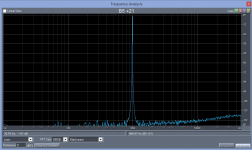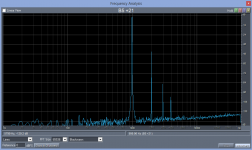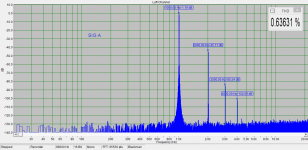In the next test people should to say what soft player and output sound mode.
Yes, but it might not be enough. IME it is really helpful to make a loopback test and measurement of the system used for the listening test. Play the pure sine from the SW player you use and record it by ADC and analyze it. Audacity can make it for free. And as a test file, sig1.wav from my latest sine test may be used. It is in 96/16. I may prepare files from 44.1/16 to 96/24 if there is anyone interested. But they can be generated by Audacity as well.
OK, using a Yamaha HT receiver driving Fostex headphones I don't hear a difference in the flute or in the sines. I got 9/16 on the flute and didn't bother running a trial on the sines, as I couldn't hear a difference to latch onto.
I tried several playback levels whith no different results. What differences are you hearing in the sine wave?
I tried several playback levels whith no different results. What differences are you hearing in the sine wave?
i guess i should apologize for messing things up early on when i expressed a preference!
for a while the the votes seemed to follow my expressed preference "tube adherents"
and now the no "tube is good" crowd are weighing in
and if i appear bold or lacking humility it's certainly not my intent just trying to state my perception honestly.
for a while the the votes seemed to follow my expressed preference "tube adherents"
and now the no "tube is good" crowd are weighing in
and if i appear bold or lacking humility it's certainly not my intent just trying to state my perception honestly.
I couldn't hear a difference with the flute, can hear a clear difference with the sines which I'm pleased about given my tinnitus and hearing loss. It's difficult to describe the sine difference, it doesn't sound pure by comparison, I suppose at the push you could describe it as a chord, and yet it doesn't sound pleasant.OK, using a Yamaha HT receiver driving Fostex headphones I don't hear a difference in the flute or in the sines. I got 9/16 on the flute and didn't bother running a trial on the sines, as I couldn't hear a difference to latch onto.
I tried several playback levels whith no different results. What differences are you hearing in the sine wave?
I tried several playback levels whith no different results. What differences are you hearing in the sine wave?
sig1 is a pure sine and siga is a distorted sine. Spectra attached. When listening to sig1 (at low volume level!!!!), the tone is clean and a bit painful. It is one uncolored frequency. When listening to siga at the same volume, you can clearly hear added coloration, H2, octave above base tone. If you use too high volume, your ear makes the same distortion effect on a pure tone, because of ear distortion. Please take into account that ear is nonlinear and creates its own distortion. Play sig1, decrease level until the tone is clean and then make the test.
Once again, you must have low distortion headphones/speakers and use low volume.
This test may disclose distortion of your system and your ear - thresholds of audibility of one or another.
Speaking about flute test, I think it is impossible to tell the difference.
Attachments
Last edited:
I wonder if it is a volume issue with those that aren't hearing it, I tend to listen at what I feel is below average level. And I wouldn't call the pure sine "painful", that's interesting
No, it starts much earlier. The best resolution is about 60 - 70dB. Look at ear masking curves.
Last edited:
I looked at spectrum analysis of the sine files. Sig1.wave is a pure sine, Siga.wav has H2, H3, H4 distortion. I can't hear them on speakers or headphones.
As far as I can tell, the harmonics are H2 -48dB,H3 -82dB, H4 -102dB below the fundamental. The fundamental is 1dB below full scale. That puts H4 right at the limit of the 16 bit file, but RMAA still pulls it out. Audacity plot does not see either H3 or H4 but I can pull them out with a wave editor. That puts H3 and H4 waaaay down.
As far as I can tell, the harmonics are H2 -48dB,H3 -82dB, H4 -102dB below the fundamental. The fundamental is 1dB below full scale. That puts H4 right at the limit of the 16 bit file, but RMAA still pulls it out. Audacity plot does not see either H3 or H4 but I can pull them out with a wave editor. That puts H3 and H4 waaaay down.
OK, going to a very quiet level I "think" the overtone on siga is coming thru. At higher levels either my headphones or my ears are masking it.When listening to siga at the same volume, you can clearly hear added coloration, H2, octave above base tone. If you use too high volume, your ear makes the same distortion effect on a pure tone, because of ear distortion.
I looked at spectrum analysis of the sine files. Sig1.wave is a pure sine, Siga.wav has H2, H3, H4 distortion. I can't hear them on speakers or headphones.
As far as I can tell, the harmonics are H2 -48dB,H3 -82dB, H4 -102dB below the fundamental. The fundamental is 1dB below full scale. That puts H4 right at the limit of the 16 bit file, but RMAA still pulls it out. Audacity plot does not see either H3 or H4 but I can pull them out with a wave editor. That puts H3 and H4 waaaay down.
Your analysis is quite correct. Audacity is very poor as a spectrum analyzer. You need to decrease FFT size to some 8192 (from 65536), spectrum becomes broader and visible. They have very poor visualization algorithm.
if it starts much earlier how the hell can expect to mix "live sound"?
if your talking frequency response i fit the statistic mean in that i have widest range at 94 (and when recording try to monitor at that level)
tried different volume levels with both the sine and flute and cannot distinguish any perceivable difference.
if your talking frequency response i fit the statistic mean in that i have widest range at 94 (and when recording try to monitor at that level)
tried different volume levels with both the sine and flute and cannot distinguish any perceivable difference.
I wonder if those that are used to measuring stuff have given up listening.... I can't wait till tomorrow to see how wrong I am 😀
I can't wait till tomorrow to see how wrong I am 😀
Could be we Europeans are just superior...
 I can't wait till tomorrow to see how wrong I am 😀
I can't wait till tomorrow to see how wrong I am 😀Could be we Europeans are just superior...
I wonder if those that are used to measuring stuff have given up listening....I can't wait till tomorrow to see how wrong I am 😀
Could be we Europeans are just superior...
Not sure if I am getting you, but measuring leads to better hearing 😛😉😀. And measuring is done to have better sound reproduction 😀
This is the siga analysis, quite precise. This should/must/is be audible at proper level with low distortion headphones and also low distortion speakers. Not with toys.
Attachments
A friendly dig at Pano, he likes to measure stuff. Maybe I should take it up if it will make my hearing even better, haha. Like I said chromebook through Grados I can easily hear the difference, can't prove it I'm afraid....
I only have a chromebook, so can't use foobar, will happily give something else a go if anyone knows of any chromebook apps I can use
Now it's getting interesting - would those who say they can hear a difference on Sine WAV do a Foobar ABX test & mention what equipment they are using?
Last edited:
I just ran the sine test again, this time for 16 attempts. Just one little error crept in at the beginning, which is probably entirely an error by me in hitting the incorrect button.
Using inbuilt laptop speakers at very low volume as shown. So the audio chain is as poor as it gets.
Using inbuilt laptop speakers at very low volume as shown. So the audio chain is as poor as it gets.
Attachments
- Home
- General Interest
- Everything Else
- Can you tell original file from tube amp record? - test



